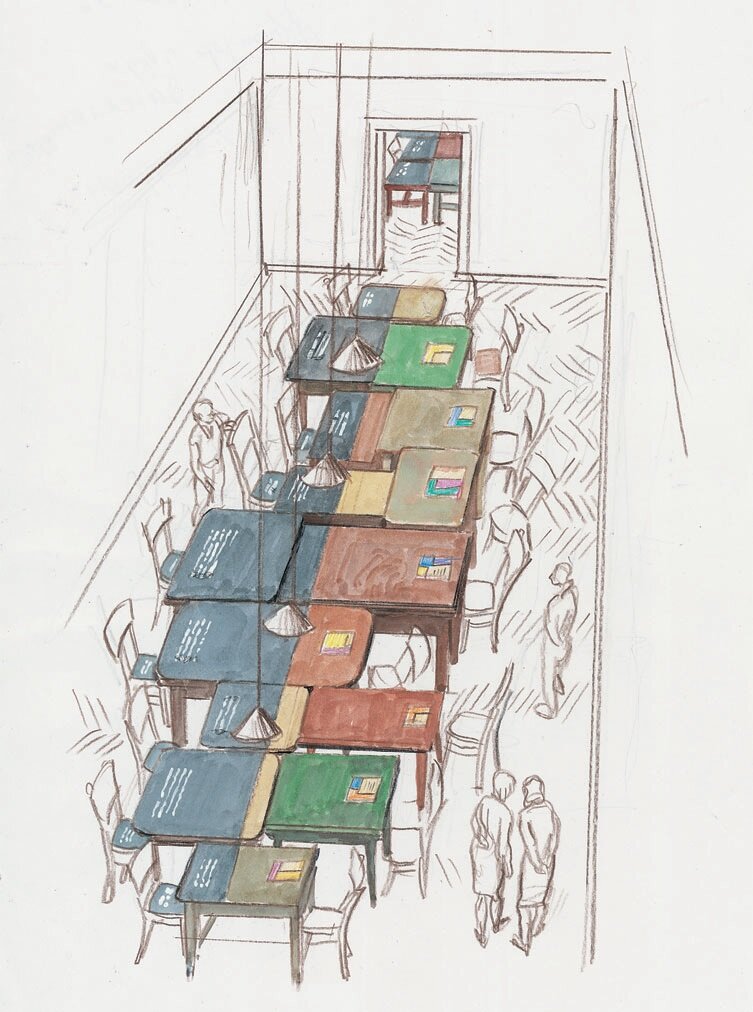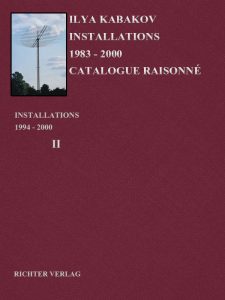The Corridor of Two Banalities
YEAR: 1994
CATALOGUE NUMBER: 80
NOTES
with Joseph Kosuth
PROVENANCE
Collection of the artist
EXHIBITIONS
Warsaw, Centrum Sztuki Współczesnej Zamek Ujazdowski (Center for Contemporary Art, Ujazdowski Castle)
Korytarz dwóch banalnósc, 25 Apr 1994 — 3 Sep 1994
Zilina, Povazská Galéria Umenia v Ziline (PGU-Gallery)
Koridor Dvoch Banalít, 14 Oct 1996 — 24 Nov 1996
Kiev, International Charitable Foundation, Center for Contemporary Art
Ilya Kabakov / Joseph Kosuth: The Corridor of Two Banalities, 4 Dec 1999 — 14 Feb 2000
DESCRIPTION
The exhibit was specifically designed for the space in the Ujazdowski Castle in Warsaw. The first floor of the castle consists of long halls running from the entrance, one after the other, with old windows on the left side. We ordered 112 antique tables for the installation (or perhaps it is better to say, ‘old’ tables, but it was still difficult to find such a large quantity of them, especially since we wanted them to be rectangular). We placed the tables together in pairs in such a way that they formed a long row inside the room, and in this way, they moved from one room to the next. Then we drew a line exactly in the middle of these tables, and we painted one side of the line gray, and the other remained untouched. The seats of the chairs were also painted gray. The gray side of the tables was given to Kosuth, who wrote on each of these parts of the tables (or more accurately, he printed) one quote by some great historical figure: Stalin, Rousseau, Trotsky, etc. On his side of the table, Kabakov glued collages on colored paper, where amidst Soviet postcards could be found a typewritten text with the complaints and appeals of residents of communal apartments to the police and courts for the ‘excesses’ of his apartment-mates. Hence, the viewer could walk along both sides of the tables, and on both sides, he could read texts.1 All the halls were semi-dark, with light coming from low, hanging bulbs falling only on the surface of the tables and texts.
Two Letters to Kosuth
Letter No. 1
Dear Joseph!
Like me, you use quotes in many of your works. The use of the speech of other people who did not at all anticipate that their texts would be manipulated places those who do this in a very special relationship with these people, and with many aspects of such a situation. The questions that I formulate below arise under such circumstances:
What do you think: would the authors of the quotes you use consent to the way you use them?
Would they agree to be placed next to one another in the series you arrange?
Do you feel that these fragments of speech can be used by you without considering the context in which they were spoken?
Some of the phrases of famous people sound like profound maxims intended to be taken ‘seriously.’ They acquire a different ‘nuance’ in the installation. What is that nuance, and what goal do you have in mind here?
By arranging rows of quotes, to a great degree, you annihilate the meaning and value of each of them individually. Is this so? Do you feel you have a right to do this?
Letter No. 2
Dear Joseph!
You are right about the arrangement of the tables, calling them a dual monologue. Furthermore, such rows of tables extending the entire length of the exhibit evoke extraordinary boredom and a desire to leave. Your proposal for composing the tables so that two utterances – yours and mine – can ‘sit’ opposite at the tables will not do in our ‘meeting’ and this is why. I know your texts, but you haven’t seen and don’t know ‘mine’ (we need to do this when we meet). The thing is that individuals perform for ‘you‘ – each one of them is a personality and is great. Mine comprise just a single, unified ‘faceless and senseless mass,’ even though the names are documented there: Petrov, Ivanov, etc. A personality cannot sit opposite a single ant that has been plucked from the anthill! The whole essence of our installation, as I have explained, is in the boundary encountered by the anonymous ‘kasha’ of faceless people on one side, and the individual personalities on the other. But this very meeting of the ‘banal mass’ with the many personalities also turns them into banalities (which, by the way, is what you do in your work). Therefore, this is not a dialogue (which is impossible), but rather the ‘mutterings’ of each person about his or her own matters while bumping right up against one another. Therefore, I ask that you consider this in my composition of the tables.
CONCEPT OF THE INSTALLATION
In the spring of 1994, at the suggestion of Joseph Kosuth, we decided to do a joint exhibit-installation. After thinking about a few options, we settled on the one that we called The Corridor of Two Banalities.
As a result, what emerged was a kind of ‘conference’ between West and East. In the West, all the people were famous, important, major personalities; they all say something important to all of humanity – not wordy, but magnificent – something that merited attention. These were the pretensions of these utterances and personalities. On the side of the ‘East,’ the voices were not of some grand personalities, but rather some sort of chorus, of some faceless mass, where one voice could be replaced by the next, and each of them was filled with pain, insult, and complaint. Hence, it was as though both kinds of people were sitting on opposite sides at these tables, almost right up against one another, but they can’t hear one another. The boundary between them is not one that is physical, but rather internal, and appears to be insurmountable. The position of the viewers with regard to the installation replicates this very situation. If the viewers walk along one side, then they can read only what is turned toward them. The texts on the other side are ‘upside down,’ and it is impossible to read them, and it is also impossible to cross over onto the ‘other’ side since there are no openings between the tables for the entire length of the installation. One can only cross over to the other side either in the very beginning or at the very end, and then the viewer would have to walk through the whole installation again, reading, ‘listening to,’ only the other side: either West or East.
Images
Literature








